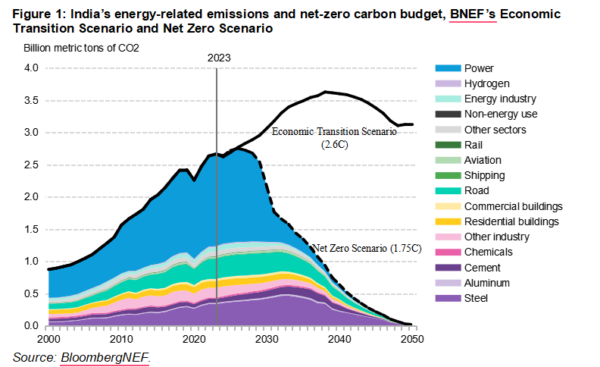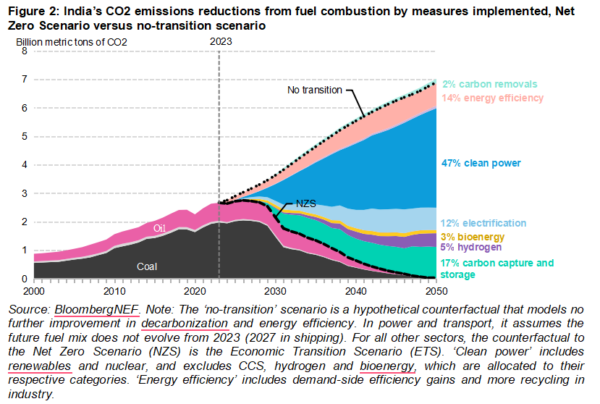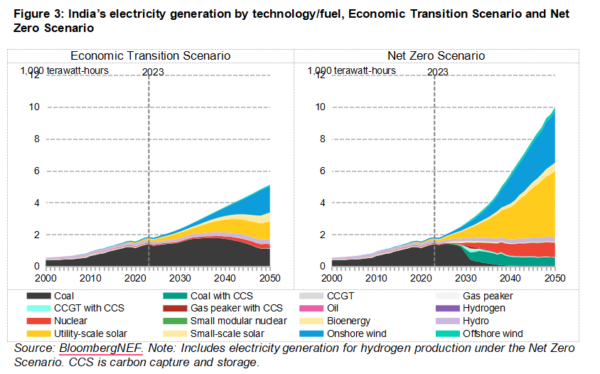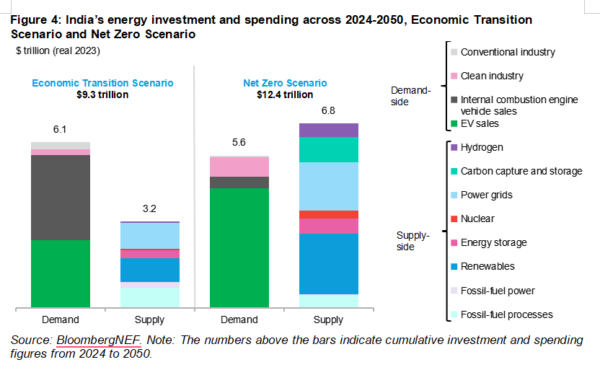BloombergNEF’s ‘New Energy Outlook 2024: India’ details how the country can accelerate its decarbonization trajectory in line with the Paris Agreement commitment.
The report states that India must rapidly decarbonize its power sector – the largest emitter in the country – to stay on track, more than tripling its solar and wind capacity by 2030 to 494 GW in BNEF’s Net Zero Scenario. It shows that India’s energy mix needs to transform over the next two decades, with all unabated fossil-fuel-based power generation exiting the grid by 2045. India’s electricity output shifts to a mix of low-cost renewables paired with flexible technologies like batteries, pumped hydro, and gas peakers.

“India’s window to stay on a well-below-2-degrees pathway is closing, fast, said Shantanu Jaiswal, head of BNEF in India and Southeast Asia. “Rapidly moving to a clean power system based on wind, solar and energy storage will be essential to cost-effectively reduce carbon emissions. A low-carbon power sector will form the bedrock for emissions-reduction efforts in other areas of the economy in the years to come. Most of the heavy lifting in India’s emission-abatement trajectory must be done in the next decade as emissions from all sectors must peak within the next 10 years.”
The NZS, which is consistent with a 67% chance of holding global warming to 1.75 degrees Celsius, shows there is limited room for further carbon emissions growth and that the peak needs to be accelerated across all sectors within the next ten years. India’s emissions from power, transport and buildings sectors must peak in this decade, followed by industrial emissions by the early 2030s, and then rapidly decline using a mix of mature and nascent technology pathways.
The alternative scenario, the ETS, which assumes no new policies are implemented, breaches the Paris Agreement with a global warming result of 2.6 degrees Celsius, and demonstrates how far the energy transition can go based on economical and commercially ready technologies.

India is one of the few countries that would achieve its updated Nationally Determined Contribution (NDC), even under BNEF’s base-case economics-led pathway. However, the NZS results imply that for India to remain aligned with the Paris Agreement, the country’s emissions increase from energy-related sectors needs to be limited to only 106% by 2030 relative to its 2005 baseline – far below the 175% increase in the ETS and the 192% jump implied by its NDC.
The report states that in the NZS, cleaning up the power sector accounts for nearly half of all emissions avoided between today and 2050, compared with a no-transition scenario, in which there is no further action on decarbonization. Electrification of end-use sectors, including road transport, buildings and industry, accounts for a further 12% of avoided emissions. By 2050, India’s power system grows dramatically and re-orientates entirely to clean power technologies. Wind and solar installations reach a combined 4,328 GW by mid-century. Storage, in the form of pumped hydro and batteries, increases from around 5 GW today to over 770 GW.
“India’s 4 terawatts of wind and solar build from now through mid-century represents a $2.1 trillion investment opportunity for the industry, said BNEF India analyst Siddharth Shetty, the lead author of the report. “A renewables-heavy system also poses severe grid-balancing challenges. We need flexibility in the system not just in the form of batteries and pumped hydro on the supply side but also in the form of electrolyzers and smart vehicles charging on the demand side.”

The technologies and clean fuels needed to abate the remaining two-fifths of emissions are among the most challenging to scale: biofuels for shipping and aviation; clean hydrogen as well as carbon capture and storage for use by heavy industry and power. By 2050, India’s annual hydrogen consumption jumps more than 10-fold to 64 million tons relative to 2023, and carbon capture increases to 1.4 billion metric tons per year under the Net Zero Scenario.

The analysis estimates India’s energy sector investment and spending under the Net Zero Scenario, at $12.4 trillion over 2024-50, 34% (or about $3 trillion) higher than in the Economic Transition Scenario. To get on track for net zero, it highlights the need to scale up key technologies like renewable power, electric vehicles, battery energy storage, nuclear energy, carbon capture and storage, hydrogen, sustainable aviation fuels and power networks.
This content is protected by copyright and may not be reused. If you want to cooperate with us and would like to reuse some of our content, please contact: editors@pv-magazine.com.









By submitting this form you agree to pv magazine using your data for the purposes of publishing your comment.
Your personal data will only be disclosed or otherwise transmitted to third parties for the purposes of spam filtering or if this is necessary for technical maintenance of the website. Any other transfer to third parties will not take place unless this is justified on the basis of applicable data protection regulations or if pv magazine is legally obliged to do so.
You may revoke this consent at any time with effect for the future, in which case your personal data will be deleted immediately. Otherwise, your data will be deleted if pv magazine has processed your request or the purpose of data storage is fulfilled.
Further information on data privacy can be found in our Data Protection Policy.